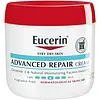What's inside
What's inside
 Key Ingredients
Key Ingredients

No key ingredients
 Benefits
Benefits

No benefits
 Concerns
Concerns

 Ingredients Side-by-side
Ingredients Side-by-side

Water
Skin ConditioningGlycerin
HumectantUrea
BufferingCetearyl Alcohol
EmollientHydrogenated Coco-Glycerides
EmollientOctyldodecanol
EmollientCaprylic/Capric Triglyceride
MaskingButyrospermum Parkii Butter
Skin ConditioningSodium Lactate
BufferingGlyceryl Stearate Se
EmulsifyingCeramide NP
Skin ConditioningLactic Acid
BufferingArginine Hcl
Skin ConditioningGlycine
BufferingAlanine
MaskingCarnitine
CleansingSodium PCA
HumectantCarrageenan
Cholesterol
EmollientHelianthus Annuus Seed Oil
EmollientTapioca Starch
Dimethicone
EmollientPentylene Glycol
Skin ConditioningPhenoxyethanol
PreservativeDecylene Glycol
Skin ConditioningAcrylates/C10-30 Alkyl Acrylate Crosspolymer
Emulsion StabilisingSodium Cetearyl Sulfate
CleansingSodium Chloride
MaskingWater, Glycerin, Urea, Cetearyl Alcohol, Hydrogenated Coco-Glycerides, Octyldodecanol, Caprylic/Capric Triglyceride, Butyrospermum Parkii Butter, Sodium Lactate, Glyceryl Stearate Se, Ceramide NP, Lactic Acid, Arginine Hcl, Glycine, Alanine, Carnitine, Sodium PCA, Carrageenan, Cholesterol, Helianthus Annuus Seed Oil, Tapioca Starch, Dimethicone, Pentylene Glycol, Phenoxyethanol, Decylene Glycol, Acrylates/C10-30 Alkyl Acrylate Crosspolymer, Sodium Cetearyl Sulfate, Sodium Chloride
 Reviews
Reviews

Ingredients Explained
These ingredients are found in both products.
Ingredients higher up in an ingredient list are typically present in a larger amount.
Phenoxyethanol is a preservative that has germicide, antimicrobial, and aromatic properties. Studies show that phenoxyethanol can prevent microbial growth. By itself, it has a scent that is similar to that of a rose.
It's often used in formulations along with Caprylyl Glycol to preserve the shelf life of products.
Water. It's the most common cosmetic ingredient of all. You'll usually see it at the top of ingredient lists, meaning that it makes up the largest part of the product.
So why is it so popular? Water most often acts as a solvent - this means that it helps dissolve other ingredients into the formulation.
You'll also recognize water as that liquid we all need to stay alive. If you see this, drink a glass of water. Stay hydrated!
Learn more about Water